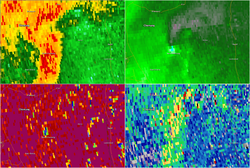Earth:M.R.L.E.
{{Multiple issues|
Mid-Volume Rescan of Low-Level Elevations, colloquially known as M.R.L.E., is a dynamic scanning option for the WSR-88D derived from MESO-SAILS,[1] a separate scanning option implemented in NEXRAD RPG 14.0, in the Spring of 2014.[2]
Concept
The concept of MRLE derives from the need of more frequent low-level scans during Quasi-Linear Convective Systems, or QLCS'. During QLCS', it is not uncommon for brief and otherwise un-noticeable mesovortices to spawn at points along the line.[3] Due to untimely radar data and time being taken to complete the entire volume, these vortices often spawn without warning or prior notice. With MRLE, the operator has the choice between 2 to 4 low-level scans. Unlike MESO-SAILS, which scans at one angle and can only do up to 3 low-level scans per volume, MRLE scans at 4 possible angles, and can cut into a volume up to 4 times, depending on the operators choice. The angles are as followed, alongside their respective scan frequencies:
- MRLEx2 = 0.5° and 0.9° elevations
- MRLEx3 = 0.5°, 0.9° and 1.3° elevations
- MRLEx4 = 0.5°, 0.9°, 1.3° and 1.8° elevations[4]
The operator can not use MESO-SAILS alongside MRLE simultaneously. If one is selected while the other is active, the NEXRAD algorithms will automatically set the other "off".
Deployment
Deployment is anticipated by the Radar Operations Center to commence in October 2017, along with the RPG 18.0 build, on a non-operational basis. The scanning option will only be available for use with Volume Coverage Patterns 21, 12, 212, and additionally 215.[5] If proven to be significant in terms of warning dissemination, MRLE will deploy operationally nationwide with RPG 18.0, planned for 2018.
References
- ↑ "Archived copy". Archived from the original on 2017-01-19. https://web.archive.org/web/20170119232850/https://www.roc.noaa.gov/wsr88d/PublicDocs/NewTechnology/Supplemental_Adaptive_Intra_Volume_Low_Level_Scan_Description_Document_Final.pdf. Retrieved 2017-03-07.
- ↑ "Archived copy". Archived from the original on 2017-04-27. https://web.archive.org/web/20170427030703/https://www.roc.noaa.gov/wsr88d/PublicDocs/NewTechnology/DQ_QLCS_MRLE_June_2016.pdf. Retrieved 2017-04-27.
- ↑ "mwr2650 1514..1532" (PDF). http://www.spc.noaa.gov/misc/AbtDerechos/papers/Atkins2_2009.pdf. Retrieved 2017-04-27.
- ↑ "Archived copy". Archived from the original on 2017-01-25. https://web.archive.org/web/20170125213140/https://www.roc.noaa.gov/wsr88d/PublicDocs/NewTechnology/MRLE_General_Description_Doc_May_2016_V01.pdf. Retrieved 2017-03-07.
- ↑ "New Radar Technology". https://www.roc.noaa.gov/WSR88d/NewRadarTechnology/NewTechDefault.aspx. Retrieved 2017-04-27.
Bibliography
- Tuftedal, Kristofer S. (December 2016) (pdf). Radar Detection of Tornadogenesis. Iowa State University. http://lib.dr.iastate.edu/cgi/viewcontent.cgi?article=1016&context=mteor_stheses.


